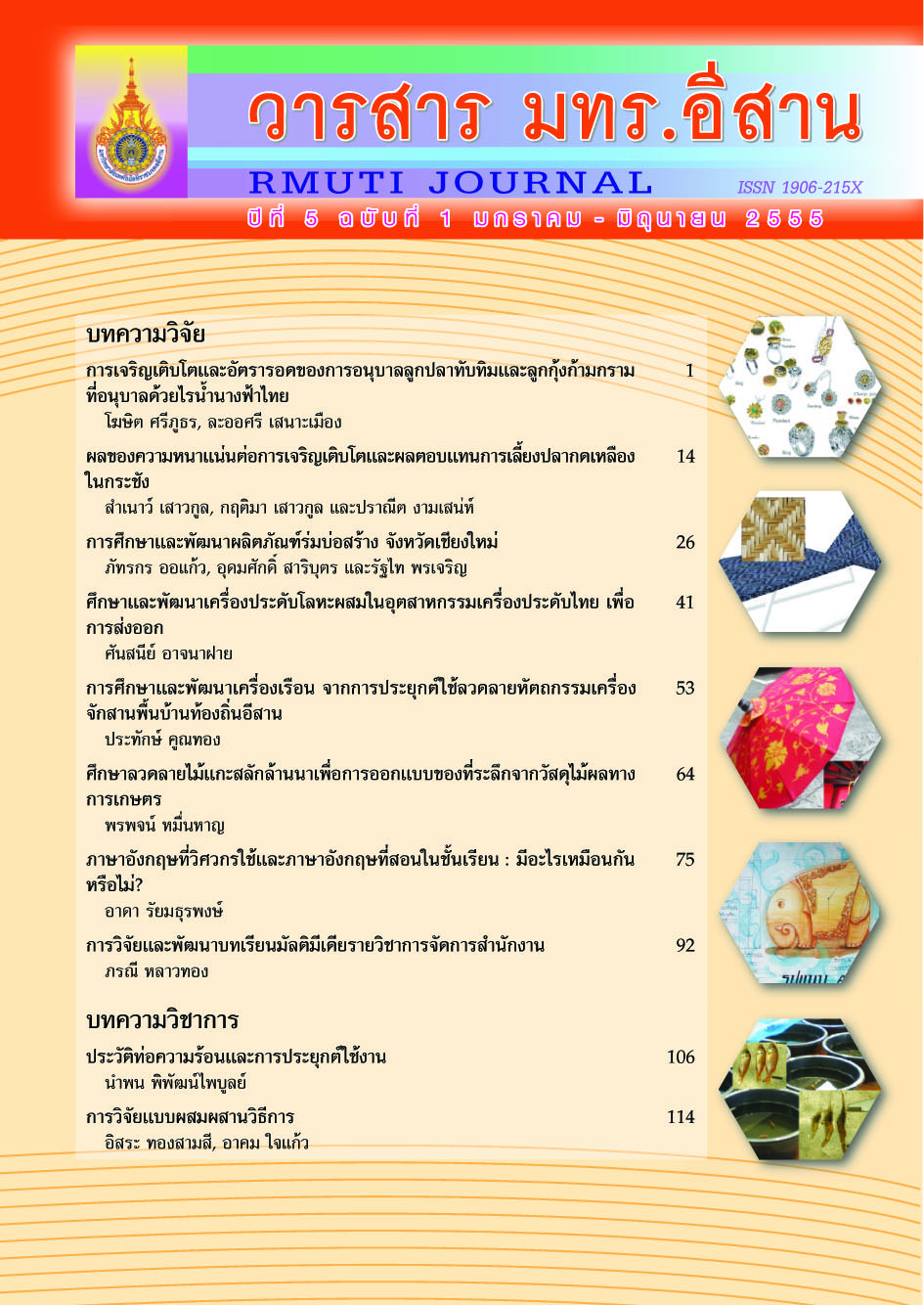ผลของความหนาแน่นต่อการเจริญเติบโตและผลตอบแทนการเลี้ยงปลากดเหลือง ในกระชัง
Main Article Content
บทคัดย่อ
บทคัดย่อ
การศึกษาผลของความหนาแน่นต่อการเจริญเติบโตและผลตอบแทนการเลี้ยงปลากดเหลืองในกระชัง ขนาด 1x2 x0.9 เมตร ในอ่างเก็บนํ้ามหาวิทยาลัยเทคโนโลยีราชมงคลอีสาน วิทยาเขตสุรินทร์ ระหว่าง เดือนมีนาคม 2553 ถึง เดือนสิงหาคม 2553 วางแผนการทดลองแบบสุ่มตลอด มี 3 ชุดทดลอง ๆ ละ 3 ซํ้า อัตราความหนาแน่น 3 ระดับ คือ 100 120 และ 140 ตัวต่อตารางเมตร โดยให้อาหารเม็ดสำเร็จรูป ชนิดเม็ดลอยนํ้า มีองค์ประกอบโปรตีน 30 เปอร์เซ็นต์ ปล่อยปลาขนาดความยาวเฉลี่ย 14.54 ± 1.81 13.50 ± 1.63 และ 13.84 ± 1.21 เซนติเมตร และนํ้าหนักเฉลี่ย 42.57 ± 2.69 43.15 ± 2.10 และ 42.69 ± 2.97 กรัม เป็นระยะเวลา 6 เดือน เมื่อสิ้นสุดการทดลองพบว่าปลากดเหลืองมีความยาวเฉลี่ย 30.69 ± 1.98 28.20 ± 1.87 และ 29.33 ± 1.86 เซนติเมตร และนํ้าหนักเฉลี่ย 242.69 ± 18.31 226.01 ± 20.45 และ 223.76 ± 6.92 กรัมตามลำดับ ซึ่งไม่มีความแตกต่างกันทางสถิติ (P>0.05) มีอัตราการรอดตาย ค่าเฉลี่ยเท่ากับ 93.33 ± 2.08 92.06 ± 3.37 และ 92.86 ± 3.57 เปอร์เซ็นต์ พบว่าไม่มีความแตกต่างกัน ทางสถิติ (P>0.05) และอัตราการเปลี่ยนอาหารเป็นเนื้อที่ระดับความหนาแน่น 100 ตัวต่อตารางเมตร มีค่าเฉลี่ยเท่ากับ 1.56 ± 0.04 มีค่าไม่แตกต่างกันทางสถิติกับที่ระดับความหนาแน่น 120 ต่อตารางเมตร มีค่าเฉลี่ยเท่ากับ 1.62 ± 0.08 ซึ่งแตกต่างจากที่ระดับความหนาแน่น 140 ตัวต่อตารางเมตร มีค่าเฉลี่ย เท่ากับ 1.67 ± 0.05 และเมื่อพิจารณาผลตอบแทนการลงทุนการเลี้ยงปลากดเหลืองในกระชังที่ระดับ ความหนาแน่น 100 ตัวต่อตารางเมตร เท่ากับ 68.86 ± 2.43 เปอร์เซ็นต์ มีผลตอบแทนมากกว่า ระดับความหนาแน่น 120 และ 140 ตัวต่อตารางเมตร มีค่าเท่ากับ 67.41 ± 2.56 และ 64.56 ± 3.65 เปอร์เซ็นต์ ตามลำดับ
คำสำคัญ : ปลากดเหลือง, ความหนาแน่น, กระชัง
Abstract
The effect of stocking density on growth performance and economic returns of green catfish (Hemibagrus filamentiis Fang & Chaux, 1949) cultured in experimental floating cages was conducted using the Complete Randomized Design (CRD) with 3 replicates of 3 stocking densities (SD): 100, 120 andl40 fish/m2. Fish of initial average size of 14.54 ± 1.81 13.50 ± 1.63, and 13.84 ± 1.21 cm in length and 42.57 ± 2.69 43.15 ± 2.10 and 42.69 ± 2.97 g in body weight were stocked in 1 X 2 X 0.9 m cages. Fish were fed with pellet diet containing 30 % protein twice a day (5% body wt/day) for six months. The results showed that SD had no significant influence on growth performance of fish. There was no significant difference (P>0.05) observed in final weights (242.69 ± 18.31 226.01 ± 20.45 and 223.76 ± 6.92 g), final lengths (30.69 ± 1.98 28.20 ± 1.87 and 29.33 ± 1.86 cm), and survival rates (93.33 ± 2.08 92.06 ± 3.37 และ 92.86 ± 3.57) in respect to different densities. Whilst feed conversion ratios of fish in both 100 and 120 fish/m2 (i.e. 1.56 ± 0.04 and 1.62 ± 0.08, respectively) were not significant different, these obviously were different in comparison to the ratio of fish in the 140 fish/m2 (1.67 ± 0.05). Research findings showed that returns of investments in the cage culture of green catfish in the 100 fish/m2 (68.86 ± 2.43 %) economically were higher in comparisons to those of fish in both 120 and 140 fish/m2 (67.41 ± 2.58 and 64.56 ± 3.65 %, respectively).
Keyword : green catfish, Hermibagrus filamentus, stocking density, cage

